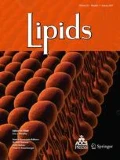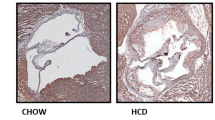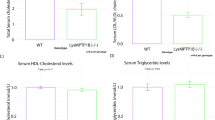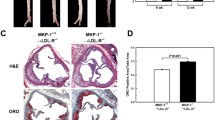Abstract
We have previously reported that phosphoinositide 3-kinase p110δ knockout (p110δ KO) diminished the adhesion of leukocytes to capillary venules and suppressed the peritoneal infiltration of leukocytes, both functions that play important roles in atherosclerosis. Therefore, we hypothesized that p110δ deficiency might be protective against atherosclerosis. Apolipoprotein E knockout (ApoE KO) mice were crossed with p110δ KO mice to generate homozygous double knockout mice (ApoE/p110δ DKO). The present study showed that ApoE/p110δ DKO mice fed with a high cholesterol diet (HCD) demonstrated less peritoneal infiltration of leukocytes and monocytes compared with ApoE KO mice after intraperitoneal injection of thioglycollate, an inducer of acute peritoneal inflammation. Unexpectedly, atherosclerosis in the aortic root and in the entire aorta was similar between the ApoE/p110δ DKO and ApoE KO groups. No difference in Mac-3 expression, indicative of macrophage infiltration, was found between the two groups. Further analysis showed that ApoE KO mice chronically fed with HCD had increased levels of total cholesterol, low-density lipoprotein in the blood and counts and percentages of circulating monocytes compared with ApoE KO mice fed with a normal diet. Consistently, the deficiency of p110δ affected neither the counts nor the percentages of monocytes nor the lipid profiles in the blood. The results suggested that p110δ plays an important role in acute but not in chronic inflammation, the latter being included in the early characteristics of atherosclerosis, which might explain the finding that p110δ deficiency fails to inhibit early atherosclerosis.




Similar content being viewed by others
Abbreviations
- ApoE KO:
-
Apolipoprotein E knockout
- DBA:
-
3′, 3′-Diaminobenzidine
- HCD:
-
High cholesterol diet
- HDL-C:
-
HDL cholesterol
- IPP:
-
Image-Pro Plus
- LDL:
-
Low-density lipoprotein
- LDL-C:
-
LDL cholesterol
- ND:
-
Normal diet
- oxLDL:
-
Oxidatively modified low-density lipoprotein
- p110δ KO:
-
Phosphoinositide 3-kinase p110δ knockout
- PBS:
-
Phosphate-buffered saline
- PI3K:
-
Phosphoinositide 3-kinase
- TAG:
-
Triacylglycerol
- TBARS:
-
Thiobarbituric acid reactive substances
- TC:
-
Total cholesterol
References
Gurfinkel E, Lernoud V (2006) The role of infection and immunity in atherosclerosis. Expert Rev Cardiovasc Ther 4:131–137
Hansson GK (2001) Immune mechanisms in atherosclerosis. Arterioscler Thromb Vasc Biol 21:1876–1890
Fuster V (1994) Lewis A. conner memorial lecture. Mechanisms leading to myocardial infarction: insights from studies of vascular biology. Circulation 90:2126–2146
van der Zwan LP, Teerlink T, Dekker JM, Henry RM, Stehouwer CD, Jakobs C, Heine RJ, Scheffer PG (2009) Circulating oxidized LDL: determinants and association with brachial flow-mediated dilation. J Lipid Res 50:342–349
Tang FT, Qian ZY, Liu PQ, Zheng SG, He SY, Bao LP, Huang HQ (2006) Crocetin improves endothelium-dependent relaxation of thoracic aorta in hypercholesterolemic rabbit by increasing eNOS activity. Biochem Pharmacol 72:558–565
Witztum JL (1994) The oxidation hypothesis of atherosclerosis. Lancet 344:793–795
Shirai T, Hilhorst M, Harrison DG, Goronzy JJ, Weyand CM (2015) Macrophages in vascular inflammation—from atherosclerosis to vasculitis. Autoimmunity 48:139–151
Hulthe J, Fagerberg B (2002) Circulating oxidized LDL is associated with increased levels of cell-adhesion molecules in clinically healthy 58-year old men (AIR study). Med Sci Monit 8:148–152
Ueba T, Nomura S, Nishikawa T, Kajiwara M, Yamashita K (2009) Circulating oxidized LDL, measured with FOH1a/DLH3 antibody, is associated with metabolic syndrome and the coronary heart disease risk score in healthy Japanese. Atherosclerosis 203:243–248
Tang F, Lu M, Zhang S, Mei M, Wang T, Liu P, Wang H (2014) Vitamin E conditionally inhibits atherosclerosis in ApoE knockout mice by anti-oxidation and regulation of vasculature gene expressions. Lipids 49:1215–1223
Tani S, Matsumoto M, Anazawa T, Kawamata H, Furuya S, Takahashi H, Iida K, Washio T, Kumabe N, Kobori M, Nagao K, Hirayama A (2011) Development of a model for prediction of coronary atherosclerotic regression: evaluation of high-density lipoprotein cholesterol level and peripheral blood monocyte count. Heart Vessels 27:143–150
Imanishi T, Ikejima H, Tsujioka H, Kuroi A, Ishibashi K, Komukai K, Tanimoto T, Ino Y, Takeshita T, Akasaka T (2010) Association of monocyte subset counts with coronary fibrous cap thickness in patients with unstable angina pectoris. Atherosclerosis 212:628–635
Cardilo-Reis L, Witztum JL, Binder CJ (2010) When monocytes come (too) close to our hearts. J Am Coll Cardiol 55:1639–1641
Tani S, Nagao K, Anazawa T, Kawamata H, Furuya S, Takahashi H, Iida K, Matsumoto M, Washio T, Kumabe N, Hirayama A (2009) Association of leukocyte subtype counts with coronary atherosclerotic regression following pravastatin treatment. Am J Cardiol 104:464–469
Chang JD, Sukhova GK, Libby P, Schvartz E, Lichtenstein AH, Field SJ, Kennedy C, Madhavarapu S, Luo J, Wu D, Cantley LC (2007) Deletion of the phosphoinositide 3-kinase p110gamma gene attenuates murine atherosclerosis. Proc Natl Acad Sci USA 104:8077–8082
Park SJ, Min KH, Lee YC (2008) Phosphoinositide 3-kinase delta inhibitor as a novel therapeutic agent in asthma. Respirology 13:764–771
Zhuang J, Peng W, Li H, Lu Y, Wang K, Fan F, Li S, Xu Y (2013) Inhibitory effects of vinpocetine on the progression of atherosclerosis are mediated by Akt/NF-kappaB dependent mechanisms in apoE-/- mice. PLoS One 8:e82509
Guo H, Samarakoon A, Vanhaesebroeck B, Malarkannan S (2008) The p110 delta of PI3K plays a critical role in NK cell terminal maturation and cytokine/chemokine generation. J Exp Med 205:2419–2435
Durand CA, Hartvigsen K, Fogelstrand L, Kim S, Iritani S, Vanhaesebroeck B, Witztum JL, Puri KD, Gold MR (2009) Phosphoinositide 3-kinase p110 delta regulates natural antibody production, marginal zone and B-1 B cell function, and autoantibody responses. J Immunol 183:5673–5684
Dil N, Marshall AJ (2009) Role of phosphoinositide 3-kinase p110 delta in TLR4- and TLR9-mediated B cell cytokine production and differentiation. Mol Immunol 46:1970–1978
Puri KD, Doggett TA, Douangpanya J, Hou Y, Tino WT, Wilson T, Graf T, Clayton E, Turner M, Hayflick JS, Diacovo TG (2004) Mechanisms and implications of phosphoinositide 3-kinase delta in promoting neutrophil trafficking into inflamed tissue. Blood 103:3448–3456
Wang HB, Wang JT, Zhang L, Geng ZH, Xu WL, Xu T, Huo Y, Zhu X, Plow EF, Chen M, Geng JG (2007) P-selectin primes leukocyte integrin activation during inflammation. Nat Immunol 8:882–892
Okkenhaug K, Bilancio A, Farjot G, Priddle H, Sancho S, Peskett E, Pearce W, Meek SE, Salpekar A, Waterfield MD, Smith AJ, Vanhaesebroeck B (2002) Impaired B and T cell antigen receptor signaling in p110delta PI 3-kinase mutant mice. Science 297:1031–1034
Tang FT, Cao Y, Wang TQ, Wang LJ, Guo J, Zhou XS, Xu SW, Liu WH, Liu PQ, Huang HQ (2011) Tanshinone IIA attenuates atherosclerosis in ApoE(-/-) mice through down-regulation of scavenger receptor expression. Eur J Pharmacol 650:275–284
Patton DT, Garden OA, Pearce WP, Clough LE, Monk CR, Leung E, Rowan WC, Sancho S, Walker LS, Vanhaesebroeck B, Okkenhaug K (2006) Cutting edge: the phosphoinositide 3-kinase p110 delta is critical for the function of CD4 + CD25 + Foxp3 + regulatory T cells. J Immunol 177:6598–6602
Lee KS, Lee HK, Hayflick JS, Lee YC, Puri KD (2006) Inhibition of phosphoinositide 3-kinase delta attenuates allergic airway inflammation and hyperresponsiveness in murine asthma model. FASEB J 20:455–465
Ali K, Camps M, Pearce WP, Ji H, Ruckle T, Kuehn N, Pasquali C, Chabert C, Rommel C, Vanhaesebroeck B (2008) Isoform-specific functions of phosphoinositide 3-kinases: p110 delta but not p110 gamma promotes optimal allergic responses in vivo. J Immunol 180:2538–2544
Gutierrez LL, Maslinkiewicz A, Curi R, de Bittencourt PI Jr (2008) Atherosclerosis: a redox-sensitive lipid imbalance suppressible by cyclopentenone prostaglandins. Biochem Pharmacol 75:2245–2262
Febbraio M, Hajjar DP, Silverstein RL (2001) CD36: a class B scavenger receptor involved in angiogenesis, atherosclerosis, inflammation, and lipid metabolism. J Clin Invest 108:785–791
Endemann G, Stanton LW, Madden KS, Bryant CM, White RT, Protter AA (1993) CD36 is a receptor for oxidized low density lipoprotein. J Biol Chem 268:11811–11816
Acknowledgments
This work was supported by the Natural Science Foundation of China (no. 30871304), the Natural Science Foundation of China (no. 81374008) and the Talent Fund of Liaoning Medical University (no. 2014-18).
Conflict of interest
The authors declare no conflicts of interest.
Author information
Authors and Affiliations
Corresponding author
About this article
Cite this article
Tang, F., Li, X., Gui, Y. et al. p110Delta Inhibits Monocyte Infiltration by Thioglycollate-Induced Periotoneal Inflammation but Not HCD-Induced Inflammation and Atherosclerosis in APOE KO Mice. Lipids 50, 839–846 (2015). https://doi.org/10.1007/s11745-015-4026-8
Received:
Accepted:
Published:
Issue Date:
DOI: https://doi.org/10.1007/s11745-015-4026-8




